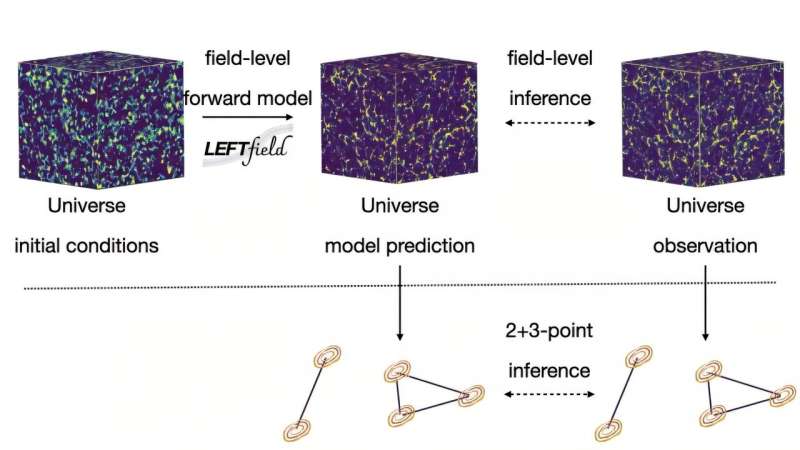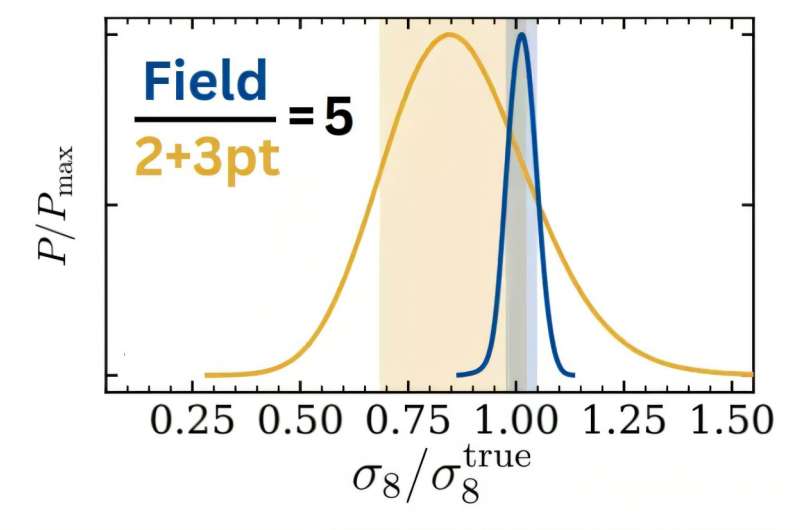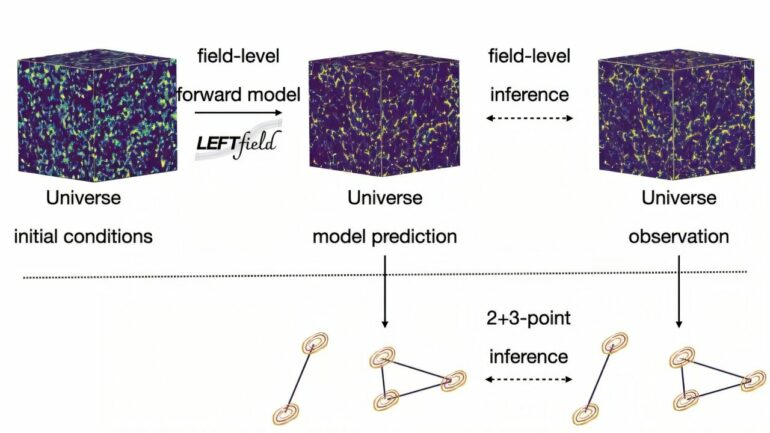Galaxies are not islands in the cosmos. While globally the universe expands—driven by the mysterious “dark energy”—locally, galaxies cluster through gravitational interactions, forming the cosmic web held together by dark matter’s gravity. For cosmologists, galaxies are test particles to study gravity, dark matter and dark energy.
For the first time, MPA researchers and alumni have now used a novel method that fully exploits all information in galaxy maps and applied it to simulated but realistic datasets. Their study demonstrates that this new method will provide a much more stringent test of the cosmological standard model, and has the potential to shed new light on gravity and the dark universe.
From tiny fluctuations in the primordial universe, the vast cosmic web emerged: galaxies and galaxy clusters form at the peaks of (over)dense regions, connected by cosmic filaments with empty voids in between. Today, millions of galaxies sit across the cosmic web. Large galaxy surveys map those galaxies to trace the underlying spatial matter distribution and track their growth or temporal evolution.
Observing and analyzing millions of galaxies turns out to be a daunting task. Hence, standard analyses first compress the three-dimensional galaxy distribution into measurements of the spatial correlation between pairs and triplets of galaxies, technically known as the two- and three-point correlation functions (see fig. 1).
These restricted statistics, however, potentially leave out a lot of information in galaxy maps, especially information encoded on smaller spatial scales. In addition, they do not tell us where in the maps to look further, should some surprising result turn up in these statistics. How much more information can be extracted?
A recent study published in Physical Review Letters by MPA researchers and alumni, led by Dr. Minh Nguyen, provides compelling evidence for significant information beyond the reach of two- and three-point functions.
For the study, the team have developed and validated a rigorous probabilistic framework, LEFTfield, to model the clustering of galaxies. How the LEFTfield framework leverages the Effective Field Theory of Large-Scale Structure (EFTofLSS) to produce robust and accurate predictions of the observed galaxy field with high efficiency was the topic of another MPA research highlight.
LEFTfield foward–models the evolution of primordial fluctuations into large-scale structure and galaxy clustering, preserving the entire information in the three-dimensional distribution of galaxies. Further, the LEFTfield forward model is differentiable, allowing for field-level inference (FLI) of both parameters in the cosmological model and the primordial fluctuations from which all structure in the universe emerged.
In the study, the team set up an apples-to-apples comparison between FLI and the standard two-point plus three-point (“2+3-pt”) inference. Both inference pipelines adopt the same LEFTfield forward model, and use the observed maps on strictly the same scales, as illustrated by figure 2.

Fig. 2. The comparison between FLI and 2+3-point inference adopts the same forward model, LEFTfield, for both inference schemes. The key difference is FLI analyzes the entire galaxy field while 2+3-point inference analyzes only the 2+3-point summaries of the (same) galaxy field. © MPA
Analyzing the same catalogs of dark-matter halos from the same set of N-body simulations, the team found that FLI improves constraints on the amplitude of structure growth by a factor of 3–5, even with conservative scale cuts in both analyses.
Discover the latest in science, tech, and space with over 100,000 subscribers who rely on Phys.org for daily insights.
Sign up for our free newsletter and get updates on breakthroughs,
innovations, and research that matter—daily or weekly.
The improvement implies that even without aggressively pushing down to very small scales—where we expect EFTofLSS or even N-body simulations to fail—much more information can still be extracted from galaxy clustering simply by opening up another dimension: getting rid of the compression of the input data.
Figure 3 compares the constraints on the amplitude of structure growth from the FLI and “2+3-pt” analyses. The parameter σ8 quantifies the typical amplitude of structure in the initial (“linear”) density field on a certain scale.

Fig. 3: Constraints on the amplitude of growth of structure σ8 are improved by up to a factor of 5 when analyzing the whole galaxy field compared to just the 2- and 3-point correlation functions. © MPA
Essentially, galaxy clustering constraints on σ8 probe the growth of structure from the early universe (where we have precise measurements thanks to the cosmic microwave background) to late times. For this reason, this is a parameter that is generally modified in non-standard cosmological models, for example, if gravity is not correctly described by General Relativity, or if dark matter is not cold.
A factor of 5 improvement in parameter constraints effectively “increases” the survey volume by more than an order of magnitude, which is a huge improvement given the time-consuming and expensive process of mapping out the galaxy distribution over a large volume. Moreover, FLI in principle guarantees optimal extraction of cosmological information: there is no data compression, hence no information loss.
While this study used dark matter halos in simulations, the conclusions also hold for significantly more realistic simulated galaxies, which were the subject of a parallel study by the Beyond-2pt Collaboration that includes two researchers from the MPA team, the FLI approach based on the LEFTfield framework again returns unbiased and improved constraint on growth of structure.
Beyond improved parameter constraints, FLI also offers numerous ways to find out where evidence for physics beyond the standard model of cosmology might come from, should such evidence appear.
Since we have samples of universes that are compatible with the data, we can look for those regions most strongly deviant from the standard model, and investigate what is unusual about them. We can also employ independent datasets, for example, by correlating the inferred matter density with gravitational lensing maps, which are an entirely different probe of structure.
The team now set their eyes on applying the novel FLI approach and LEFTfield framework to real data from galaxy surveys. To connect FLI to observations, a better understanding, hence more studies, of how observational systematics impact the model predictions at the field level will be required. A flexible-yet-efficient forward-modeling framework like LEFTfield will be the key for such studies, and for unlocking the full potential of FLI from galaxy maps.
More information:
Nhat-Minh Nguyen et al, How Much Information Can Be Extracted from Galaxy Clustering at the Field Level?, Physical Review Letters (2024). DOI: 10.1103/PhysRevLett.133.221006. On arXiv: DOI: 10.48550/arxiv.2403.03220
Provided by
Max Planck Institute for Astrophysics
Citation:
Field-level inference: Unlocking the full potential of galaxy maps to explore new physics (2025, January 7)



